|
|
 |
|
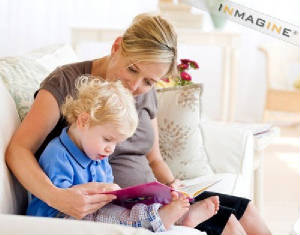
READING
AND WHY IT IS IMPORTANT TO KIDS!
Reading to Babies, Toddlers and Young Children
The
Why? The What? And the How?
What is so good about reading to children?
Reading to your child is the single most valuable thing you can do. Why?
- it gives experience
of different types of language, rhythms and sounds
- research shows
that pre-school children who are exposed to plenty of language (books and conversation) tend to do better at school
- it teaches
about many topics which wouldn't come up in conversation
- it is a wonderful
way to bond with your child
- it is very
calming
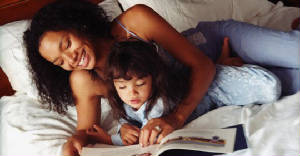
WARNING: READING must be FUN, not WORK!
Reading, and education in general, are serious matters,
but they are only meant to be serious for teachers and parents. If something isn't fun, children won't do it. And they have
BRILLIANT ways of avoiding what they don't want to do: such as pretending they can't. Or making you feel guilty.
If
your child doesn't enjoy it, he won't try. If he finds it hard, he will think he is not good at it. Your job is to make it
FUN and EASY.
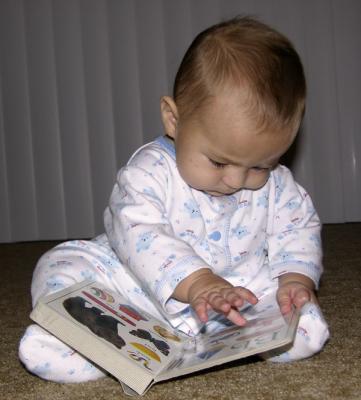
But Babies? Surely Not?
Yes, babies benefit
hugely. The effort of focusing on pictures develops eye muscles. And each time a baby hears a particular word, it
imprints more strongly in his brain. Think: how do our brains learn? They learn by doing. Each time your baby sees, hears,
or feels anything, brain connections form. Eventually, the connections are strong enough to create a skill or a piece of knowledge.
I'm Not Good at Reading Aloud
You
really don't have to be good at it. Read very slowly - that's better for your child anyway as he'll be able to hear the words
more clearly.
If you feel your reading still isn't good enough, we have two suggestions:
- practice reading
a story on your own before reading it to your child
- this is a good
time to ask for help. There are organizations which help adults with their reading. Ask your community literacy program. It
will be worth it to be able to help your child.

How to Read
First, be comfortable, cozy and relaxed - both of you. On the other
hand, hearing a story can be very calming for a child who is in 'one of those moods'.
Next, make sure your child can
see the book the right way up as you read.
For babies and toddlers up to 2 years
- point at pictures
and say or ask names of things (depending on age)
- use a slow
sing-song voice
- use different
voices for different characters - be entertaining
- spend time
talking about the pictures before turning the page
- say a name
and ask your older baby or toddler to point to the item
- give huge praise
each time your child points at and names an object.
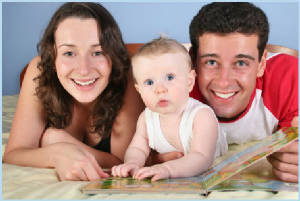
For 2-4 year-olds
- give your child
time to look at the pictures before you read
- ask, 'Where's
the...?' 'What's that called?' 'What's she doing?'
- always follow
text with your finger as you read
- with familiar
stories, see if your child can join in or finish phrases
- ask questions
like: 'Why did he do that?' 'What happens next?'
- discuss things
you both liked/didn't like and why
For 4 year-olds and over (and possibly some 3
year-olds)
- ask for names
of character of familiar books.
- ask your child
if he can remember the order of events in the story
- try paired
reading (a reading activity where a learner and a skilled reader read a text together. The learner takes over
in spots that are easy for them, giving them the confidence to read aloud even when in unsure situations.)
FINAL TIP:
Let your child see that reading is part of your life. Do you have books and newspapers in the house?
Ensure access to books from a very early age, always teach children to respect books making sure that they are not torn, written
in, or treated as toys. Books can be very valuable to young children and creating a love of books now can last an entire
lifetime.
Personal Note for PARENTS
THAT "HATE" TO READ: I would like to encourage all those parents that claim their hate to reading take a look at their learning
troubles in school as well as all the missed conversations about wonderful books others were reading, all I ask is that parents
should give their children what they themselves did not have and the gift of reading should be included in that.
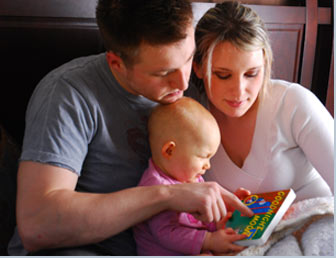
Choosing Books - For Babies, Toddlers and Nursery Children
For
babies
Very young babies cannot focus well. You need books with large, simple pictures. Bold red, green, blue and black
are usually best.
When you read to a baby you might be doing one of two things. You could be pointing at the pictures
and saying the names, which helps your baby focus on specific sounds. However, this can become just a little monotonous especially
when your baby is more interested in eating the book.
Or you could just read, so that the baby can enjoy the sound
of your voice and hear the rhythms of different types of language, even though he won't have a clue what you are talking about.
Ideally, then, you need three sorts of books for a baby:
- bright, bold
picture books to help focusing and identification
- books with
poems, songs, or stories of any sort which YOU like reading
- books that
you can safely leave in the cot, so that your baby develops a 'taste' for books. (Check safety labels carefully.)
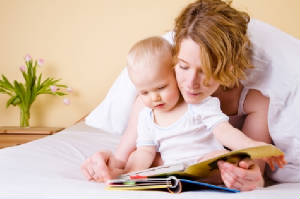
For toddlers and older pre-school children
For children who understand most of what they hear, you
need different books. Let your child choose, though some 'guidance' is often necessary.
You need these sorts of books:
- a variety of
different types of language to read to your child (including poetry, traditional stories and mystery as well as everyday stories)
- a range of
easier books with very few words, so that your child can begin to 'read' independently, by remembering a story which he has
heard often
- books which
your child really likes for whatever reason
Don't forget: the written word is all around us. We don't only read books - we read shop names, road signs, shopping
lists, advertisements, birthday cards.... All are a chance to show your child how reading works.
|
 |
Put Reading First - Raising Smart Kids!
A Parent Guide
Preschool Through Grade 3
Success in school starts with reading.
When children become good readers
in the early grades, they are more likely to become better learners throughout their school years and beyond.
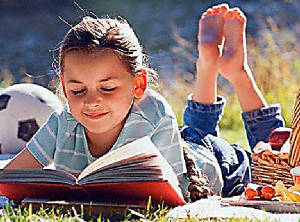
Learning to read is hard work for children. Fortunately,
research is now available that suggests how to give each child a good start in reading.
Becoming a reader involves the development of
important skills, including learning to:
- use language in conversation
- listen and respond to stories read aloud
- recognize and name the letters of the alphabet
- listen to the sounds of spoken language
- connect sounds to letters to figure out the "code" of reading
- read often so that recognizing words becomes easy and automatic
- learn and use new words
- understand what is read
Preschool and kindergarten teachers set the stage
for your child to learn to read with some critical early skills. First, second, and third grade teachers then take up the
task of building the skills that children will use every day for the rest of their lives.
As a parent, you can help by understanding what
teachers are teaching and by asking questions about your child's progress and the classroom reading program.
You can also help your children become readers.
Learning to read takes practice, more practice than children get during the school day.
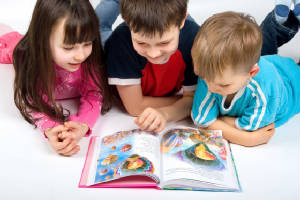
If your child is just beginning to learn to read
At school you should see teachers...
- Teaching the sounds of language. The teacher provides opportunities
for children to practice with the sounds that make up words. Children learn to put sounds together to make words and to break
words into their separate sounds.
- Teaching the letters of the alphabet. Teachers help children learn
to recognize letter names and shapes.
- Helping children learn and use new words.
- Reading to children every day. Teachers read with expression and
talk with children about what they are reading.
At home you can help by...
- Practicing the sounds of language. Read books with rhymes. Teach
your child rhymes, short poems, and songs. Play simple word games: How many words can you make up that sound like the word
"bat"?
- Helping your child take spoken words apart and put them together.
Help your child separate the sounds in words, listen for beginning and ending sounds, and put separate sounds together.
- Practicing the alphabet by pointing out letters wherever you see
them and by reading alphabet books.
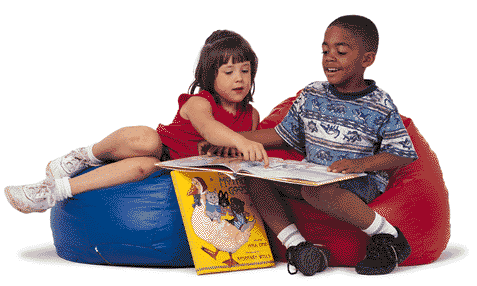
If your child is just beginning to read
At school you should see teachers...
- Systematically teaching phonics--how sounds and letters are related.
- Giving children the opportunity to practice the letter-sound relationships
they are learning. Children have the chance to practice sounds and letters by reading easy books that use words with the letter-sound
relationships they are learning.
- Helping children write the letter-sound relationships they know
by using them in words, sentences, messages, and their own stories.
- Showing children ways to think about and understand what they are
reading. The teacher asks children questions to show them how to think about the meaning of what they read.
At home you can help by...
- Pointing out the letter-sound relationships your child is learning
on labels, boxes, newspapers, magazines and signs.
- Listening to your child read words and books from school. Be patient
and listen as your child practices. Let your child know you are proud of his reading.
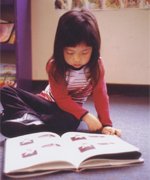
If your child is reading
At school you should see teachers...
- Continuing to teach letter-sound relationships for children who
need more practice. On average, children need about two years of instruction in letter-sound relationships to become good
spellers as well as readers.
- Teaching the meaning of words, especially words that are important
to understanding a book.
- Teaching ways to learn the meaning of new words. Teachers cannot
possibly teach students the meaning of every new word they see or read. Children should be taught how to use dictionaries
to learn word meanings, how to use known words and word parts to figure out other words, and how to get clues about a word
from the rest of the sentence.
- Helping children understand what they are reading. Good readers
think as they read and they know whether what they are reading is making sense. Teachers help children to check their understanding.
When children are having difficulty, teachers show them ways to figure out the meaning of what they are reading.
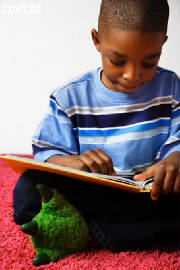
At home you can help your child by...
- Rereading familiar books. Children need practice in reading comfortably
and with expression using books they know.
- Building reading accuracy. As your child is reading aloud, point
out words he missed and help him read words correctly. If you stop to focus on a word, have your child reread the whole sentence
to be sure he understands the meaning.
- Building reading comprehension. Talk with your child about what
she is reading. Ask about new words. Talk about what happened in a story. Ask about the characters, places, and events that
took place. Ask what new information she has learned from the book. Encourage her to read on her own.

Make reading a part of every day
- Share conversations with your child over meal times and other times
you are together. Children learn words more easily when they hear them spoken often. Introduce new and interesting words at
every opportunity.
- Read together every day. Spend time talking about stories, pictures,
and words.
- Be your child's best advocate. Keep informed about your child's
progress in reading and ask the teacher about ways you can help.
- Be a reader and a writer. Children learn habits from the people
around them.
- Visit the library often. Story times, computers, homework help,
and other exciting activities await the entire family.
Put Reading First

|
 |
|
|
 |
|
|
 |
|
|
|
|

All logos within this site are copyright to their prospective
companies, KidSource Logos and custom graphics are all property of kidsource. These logos may not be used for any reason without
written consent.
Usborne is a trademark of Usborne Publishing
Limited, U.K. Usborne Publishing Limited has no connection with these pages and does not sponsor nor support their content.
The Cartwright Duck is the trademark and copyright of Usborne Publishing. All rights reserved. The
stacked books logo and acronym EDC are trademarks of Educational Development Corporation.Publishing Ltd. has no connection with these pages and does not sponsor or support their content.
|
|
|
 |

